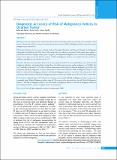Please use this identifier to cite or link to this item:
https://hdl.handle.net/20.500.14356/1278Full metadata record
| DC Field | Value | Language |
|---|---|---|
| dc.contributor.author | Baral, Gehanath | - |
| dc.contributor.author | Joshi, Rijuta | - |
| dc.contributor.author | Pandit, Benju | - |
| dc.date.accessioned | 2023-05-04T07:26:05Z | - |
| dc.date.available | 2023-05-04T07:26:05Z | - |
| dc.date.issued | 2020 | - |
| dc.identifier.citation | BaralG., JoshiR., & PanditB. (2020). Diagnostic Accuracy of Risk of Malignancy Indices in Ovarian Tumor. Journal of Nepal Health Research Council, 18(2), 253-258. https://doi.org/10.33314/jnhrc.v18i2.2627 | en_US |
| dc.identifier.issn | Print ISSN: 1727-5482; Online ISSN: 1999-6217 | - |
| dc.identifier.uri | http://103.69.126.140:8080/handle/20.500.14356/1278 | - |
| dc.description | Original Article | en_US |
| dc.description.abstract | Abstract Background: Screening test for ovarian cancer has not been developed yet but several tools exist to predict it. The aim is to find out the relative accuracy of commonly practiced versions of Risk of Malignancy Indices to predict ovarian malignancy pre-operatively. Methods: Intention to treat cross sectional study at Paropakar Maternity and Women’s Hospital in Kathmandu during last six months of year 2018. Cases with ovarian mass were taken pre-operatively with serum tumor markers, ultrasound and tumor Doppler study report. Pregnancy and diagnosed malignancy were excluded. Histopathology report traced post-operatively. All five versions of Risk of Malignancy Indices were analyzed by their predictive efficiency and different cut-off value of CA-125. Results: 116 cases of ovarian tumor from 14 to 76 years (mean=35.2±11.7) were studied. There were 8.6% (n=10) malignant pathology; and isolated high vascular flow and solid component may predict malignancy (p=0.000). Up to 12 multiples of normal CA-125 value could not demonstrate clear predictive value for malignancy (p=0.061). By sensitivity, specificity, diagnostic accuracy and predictive values were similar for Risk of Malignancy Indices-1 and RMI-5 as well as Risk of Malignancy Indices-2 and Risk of Malignancy Indices-3. Cut-off of 250 is efficient by >90% and best at 300. Sensitivity of all Risk of Malignancy Indices versions were similar at cut-off level of 200, 250 and 300. Conclusions: Isolated value of CA-125 and size of tumor are not useful. All Risk of Malignancy Indices versions are reasonably good. Risk of Malignancy Indices value of 250 or more is the best predictive cut-off. Risk of Malignancy Indices-1 and Risk of Malignancy Indices-5 as well as Risk of Malignancy Indices-2 and Risk of Malignancy Indices-3 have similar predictive accuracy. Doppler study is not mandatory. Keywords: Cut-off value; diagnostic accuracy; ovarian cancer; RMI | en_US |
| dc.language.iso | en | en_US |
| dc.publisher | Nepal Health Research Council | en_US |
| dc.relation.ispartofseries | Apr-June, 2020;2627 | - |
| dc.subject | Cut-off value | en_US |
| dc.subject | diagnostic accuracy | en_US |
| dc.subject | ovarian cancer | en_US |
| dc.subject | RMI | en_US |
| dc.title | Diagnostic Accuracy of Risk of Malignancy Indices in Ovarian Tumor | en_US |
| dc.type | Journal Article | en_US |
| local.journal.category | Original Article | - |
| Appears in Collections: | Vol. 18 No. 2 Issue 47 Apr-Jun 2020 | |
Files in This Item:
| File | Description | Size | Format | |
|---|---|---|---|---|
| 2627-Manuscript-17526-1-10-20200911.pdf | Fulltext Download | 346.92 kB | Adobe PDF |  View/Open |
Items in DSpace are protected by copyright, with all rights reserved, unless otherwise indicated.
